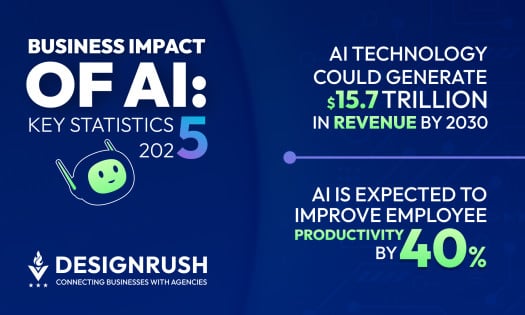Key Findings
1. Experts predict AI could generate $15.7 trillion in global revenue by 2030. Businesses can capitalize by aligning with AI trends, adopting scalable tools early, and using market forecasts to guide investments.
2. AI can boost employee productivity by up to 40%. Organizations can empower teams by automating low-value tasks, integrating AI tools, and prioritizing technology training.
3. Large enterprises are over three times more likely to adopt AI than small businesses. To close this gap, small companies should start with simple, high-impact AI tools and use cases with immediate ROI.
Wondering if AI is worth the hype? These 65 must-know statistics uncover how businesses are using artificial intelligence to grow faster and work smarter in a rapidly evolving digital industry.
Explore The Top AI Companies
Agency description goes here
Agency description goes here
Agency description goes here
How Companies Are Embracing AI — and What’s Holding Them Back
1. Big Companies Use AI, While Smaller Ones Struggle To Keep Up

AI adoption isn’t a one-size-fits-all — and that’s especially true when comparing large enterprises to smaller firms. While over 41% of large companies in the EU report using AI, that number drops to just 11.21% among small businesses.
In the U.S., More than half of companies with over 5,000 employees have already integrated AI. For companies exceeding 10,000 employees, that figure climbs to 60%, reflecting a strong correlation between company size and AI implementation. Meanwhile, just 40% of small businesses across the U.S. are using AI tools — though that still marks a significant jump from 23% in 2023.
Larger organizations tend to have the infrastructure, capital, and talent pipelines necessary to experiment with advanced tools like generative AI. Smaller businesses, on the other hand, often face budget constraints, lack of technical expertise, or uncertainty around the ROI of AI adoption.
“The biggest challenges in implementing AI are data quality, system integration, and closing the skills gap,” explains Alex Benedychuk, CEO of Regis Team. He believes the way forward is through better data practices, building cross-functional teams, and taking a phased approach to adoption.
Here are extra tips on how companies of all sizes can level the playing field:
- Start with practical use cases: Focus on solving one high-impact problem with AI, like automating emails or forecasting sales.
- Use AI-as-a-service tools: You don’t need in-house data scientists to get started — platforms like ChatGPT, Jasper, or Midjourney offer plug-and-play solutions.
- Tap into funding and support programs: Explore regional or EU grants, AI accelerators, or partnerships with academic institutions to reduce financial and technical barriers.
Below are additional statistics that reinforce the importance of size in AI adoption:
- According to Eurostat, medium-sized businesses show moderate adoption at 20.97%, suggesting scalability becomes more viable with growth.
- McKinsey claims that more than 75% of all organizations globally use AI in at least one function, but usage is concentrated in larger firms.
- 83% of companies rank AI as a strategic priority, but execution often depends on size and internal resources.
2. Where You Operate Determines How Fast You Adopt AI

Not all countries are adopting AI at the same pace. Within the EU, Denmark (27.58%), Sweden (25.09%), and Belgium (24.71%) lead in AI adoption, while Romania (3.07%) and Bulgaria (6.47%) trail far behind, showing a wide digital divide.
In Asia, India, the UAE, and China are consistently among the top countries for AI deployment and experimentation. Surprisingly, the United States has an AI deployment rate of just 33%, suggesting there’s still substantial room for growth despite its leadership in AI innovation.
High-adoption countries often benefit from strong digital infrastructure, tech-forward policies, and robust innovation ecosystems. Meanwhile, lower-adoption regions may struggle with outdated infrastructure, limited tech investment, or workforce readiness.
The following are tips on how countries and businesses within them can close the gap:
- Invest in digital infrastructure: Fast internet, cloud computing access, and affordable hardware are foundational to AI adoption.
- Promote public-private collaboration: Encourage universities, startups, and governments to co-develop and share AI solutions.
- Address skills gaps head-on: Offer AI training programs and boot camps to develop local talent and reduce reliance on external consultants.
Here are additional statistics that support the regional disparity in AI usage:
- Countries like Poland (5.90%) and Romania (3.07%) have some of the lowest AI adoption rates in the EU.
- Around 40% of Latin American business leaders were actively exploring AI solutions in 2023.
- According to Statista, the US is a global leader in AI investment and exploration, thanks to mature tech ecosystems.
- Countries with greater venture capital backing and research and development support show significantly faster AI adoption across business sectors.
3. Some Industries Are All In on AI — Others Are Barely Getting Started

Some industries are sprinting ahead with AI, while others are still tying their shoes. In the EU, the Information and Communication sector leads with a whopping 48.72% adoption rate, followed by Professional and Scientific Services (30.53%).
A similar trend is seen elsewhere: in the U.S., the Information sector reported 13.8% AI adoption in 2023, far outpacing the national average of 3.8%. Meanwhile, in Brazil, 88% of digital marketers were using AI tools by late 2024.
This gap reflects both the availability of data and the level of digital maturity within an industry. Sectors like construction or accommodation — which rely more on manual processes — report far lower AI usage, often below 10%.
Here’s how any industry can begin adopting AI intelligently:
- Audit your data: AI thrives on data, so evaluate what you’re already collecting and where it’s stored.
- Start with workflow automation: Many industries benefit from automating admin tasks, scheduling, or basic customer support using AI tools.
- Follow sector-specific leaders: Learn from companies in your field that are already deploying AI to optimize marketing, production, or logistics.
The additional statistics below further show how adoption varies by sector:
- AI is most commonly applied in IT (36%), Marketing & Sales, and Service Operations, regardless of industry.
- Industries like healthcare and finance show rapid AI integration due to time savings.
- The real estate sector lags behind at just 15.45%, and construction trails even further at 6.09%, highlighting uneven digital readiness.
- In the U.S., only 4% of construction and retail businesses have adopted it.
A Trillion-Dollar Industry in the Making That You Can Capitalize On
1. The Global AI Market Is Skyrocketing Toward the Trillions

The global AI market was valued at $279 billion in 2024 and is forecast to hit $1.81 trillion by 2030. Experts predict that it will have an expected compound annual growth rate (CAGR) of 35.9% from 2025 to 2030.
This kind of scale isn’t theoretical. It reflects real-world demand, business adoption, and public-sector investment happening right now. PwC predicts AI could generate $15.7 trillion in global revenue by 2030, making it one of the most transformative technologies in history.
Consider the following tips so you can prepare your business to ride the AI growth wave:
- Watch where capital flows: Pay attention to the sectors receiving the most AI investment (e.g., healthcare, finance, logistics) — that’s where opportunity is multiplying.
- Use growth as leverage: When pitching investors or partners, cite AI market projections to validate your roadmap and attract capital.
- Keep a long-term mindset: Rapid growth can create hype, but the sustainable impact comes from aligning AI with actual business needs, not just trends.
Take a look at the following stats that back the explosive market outlook:
- The AI market grew 5x from 2018 to 2023, driven by both private and public sector adoption.
- Revenue from AI software alone is already in the billions and is expected to reach US$9.76bn in 2025 — a sign of mainstream business demand for AI developers.
- PwC claims that AI could add trillions of USD to the global GDP by 2030 — more than the current combined GDP of Germany and Japan.
2. Smart Money Is Betting Big on AI

It’s not just startups that are diving in — tech giants and investors are pouring billions into AI. From generative tools to enterprise automation, companies like Google, Microsoft, and OpenAI are shaping the future through deep R&D and aggressive acquisitions.
And it’s paying off. Netflix reportedly earns $1 billion a year from its AI-driven recommendation engine alone. Meanwhile, venture capital continues to fund early-stage AI tools, automation platforms, and data-focused software at a record pace.
Here’s how to make strategic moves in an AI-heavy investment climate:
- Adopt proven AI use cases first: Look at where ROI is already proven — like personalization, fraud detection, or customer support.
- Follow the investor trail: Track what kinds of AI startups are getting funded — it’ll reveal trends and upcoming disruptors in your space.
- Partner or integrate early: Don’t wait to reinvent the wheel but adopt or integrate best-in-class AI tools into your current tech stack instead.
Below are additional statistics to emphasize the scale of investment:
Our experts will find the best artificial intelligence agencies for you, for free.
AI Is Shaping the Future of Work and Business Applications
1. AI Tools Are Quietly Powering More Than You Realize

You might not see it, but AI is already working behind the scenes in countless tools you use every day. From predictive analytics to language generation, these technologies are helping businesses move faster, personalize experiences, and stay competitive.
“AI is already woven into daily operations, from providing personalized customer experiences and predictive insights to automating repetitive tasks,” says Gisele Lempert Acosta, Co-founder of Optimiza Vende Más. She adds that when applied effectively, AI cuts costs, boosts efficiency, and gives businesses a strong competitive edge.
In the EU, nearly 7% of enterprises already use AI to analyze written language, and about 5.4% are generating content using AI. Meanwhile, around 24% of customer service professionals are using generative AI in countries like the U.S. and Australia. These aren’t fringe tools — they’re powering product descriptions, ad campaigns, customer service scripts, and even internal reports.
Here’s how to start integrating AI technologies without overwhelming your team:
- Audit your current tools: Many platforms already include built-in AI — explore their full capabilities before adding new software.
- Experiment with content automation: Start with low-risk tasks like summarizing reports or drafting social media posts using tools like ChatGPT or Jasper.
- Look for integrations: Most AI platforms now offer easy plug-ins with CRMs, CMSs, and project management tools for smooth rollout.
Here are additional statistics from Eurostat that showcase how AI is already being used:
- Text mining: 6.88%
- Image recognition: 4.78%
- Natural language generation: 5.41%
- Machine learning for data analysis: 4.66%
- Image processing: 3.23%
- AI for autonomous movement: 1.01%
2. AI Can Improve Processes Across Every Business Department

AI use isn’t locked in the IT department anymore. Companies are deploying AI across marketing, sales, customer support, R&D, logistics, and even cybersecurity to streamline workflows and make better, faster decisions.
Thiago Maior, CEO of EZOps Cloud, says, “AI is changing how companies handle customer service by making responses faster and more natural through smart chatbots and assistants.” He notes that success depends on adopting the right tools, training teams well, and building trust through data security.
The benefits are clear: 34.08% of AI-using EU companies say it helps with marketing and sales. Others use it to automate administration, enhance security, optimize production, and drive innovation without hiring extra headcount.
Take a look at how you can pinpoint the most impactful business functions for AI in your company:
- Find repetitive pain points: Look for processes that are high-volume but low-value — that’s where AI saves time and cost.
- Use AI for insight: Think beyond doing tasks faster — AI can help identify trends, make forecasts, and uncover hidden patterns.
- Give teams tools they’ll actually use: Choose intuitive, user-friendly platforms that integrate with your team’s workflow, so adoption doesn’t stall.
The following are some extra stats that reinforce AI’s cross-functional value:
- Admin and management support (27.51%), production optimization (24.08%), R&D and innovation (21.69%), and cybersecurity (22.54%) are key areas where businesses are applying AI across functions.
- According to McKinsey, AI is most used in IT (36%), followed by marketing and service operations.
- Only 6.12% use AI for logistics — a missed opportunity for many supply chains
AI Is Changing How People Work and the Skills Needed
1. AI Is Redefining Jobs but Not Replacing Everyone

There’s much fear around AI taking jobs, and while that’s partially true, it’s not the whole story. Yes, automation is streamlining roles in customer service, manufacturing, and supply chain, but it’s also creating entirely new job categories and career paths.
It’s important to note that we’re entering a workforce reshuffle and not a wipeout. At the end of the day, companies that reskill and reallocate talent will be the ones that thrive.
Here’s how to approach workforce changes driven by AI:
- Conduct a role-impact audit: Identify which jobs are at risk of automation and which ones are ripe for augmentation.
- Invest in upskilling programs: Prepare your workforce for AI by training them on tools, data literacy, and critical thinking.
- Reframe AI as a collaborator: Position AI as a co-pilot that handles the grunt work so humans can focus on strategy, empathy, and creativity.
Here are key statistics that highlight AI’s shifting impact on employment:
- 97 million new roles will have to be filled to satisfy the growing AI industry.
- Headcount is decreasing in supply chains and service operations while increasing in IT and product development.
- 35% of companies are using AI to compensate for labor shortages, not cut jobs.
- 96% of companies now consider generative AI mission-critical to their business operations.
- 75% of executives feel that their companies have successfully adopted generative AI.
2. AI Tools Help People Work Faster and Perform Better

Artificial intelligence platforms don’t just lead to reduced costs but are also about increasing output. AI tools are making employees faster, sharper, and more efficient across industries by taking care of repetitive, data-heavy tasks.
In fact, studies from Harvard Business School show that AI can improve employee productivity by 40%. This finding is a massive gain for teams under pressure to do more with less.
Here’s how to use AI to supercharge your team — not replace it:
- Automate grunt work: Use artificial intelligence to handle basic activities such as appointment setting and data entry, allowing your team to do other high-impact tasks.
- Let AI handle the noise: Tools that summarize meetings, classify emails, or flag anomalies reduce mental fatigue and increase decision speed.
- Monitor performance, then scale: Start small with pilot teams and track time saved or output improved — then scale across departments.
The statistics below provide further insight reinforcing AI’s productivity boost:
- PwC states that AI will increase workforce productivity by at least 30%.
- Many companies report better performance from teams using AI tools for customer service, analytics, and sales enablement.
- According to the 2025 Writer AI Survey, 88% of employees say generative AI helps them save time, collaborate more effectively, and make faster decisions.
- 77% of employees using AI are well-positioned to champion its adoption and help drive smoother implementation across their organizations.
- 98% of these champions have already contributed to developing AI tools or are eager to build new solutions.
We’ll find the best artificial intelligence companies for your next project.
AI Statistics FAQs
1. What is the biggest AI trend in 2025?
The biggest AI trend in 2025 is the rise of smart AI copilots built specifically for different jobs and industries. Businesses are using these tailored tools to work faster, make better decisions, and improve the way teams get things done.
2. How is AI used in business?
AI is used to streamline operations, personalize marketing, and automate customer support. It also helps optimize logistics and extract insights from large data sets.
3. How advanced is AI currently?
AI is more advanced than ever, powering real-time translation, content generation, and predictive decision-making. It’s already embedded in everyday business tools like project management software, email marketing platforms, and chatbots.




